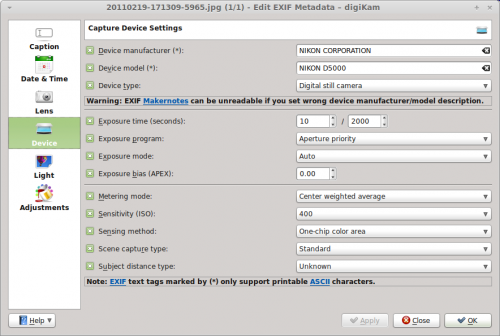Digikam/Metadata/it: Difference between revisions
Importing a new version from external source |
Importing a new version from external source |
||
| Line 6: | Line 6: | ||
All'interno di ogni fotografia digitale sono nascoste delle informazioni aggiuntive nei formati [http://it.wikipedia.org/wiki/Exchangeable_image_file_format EXIF], [http://it.wikipedia.org/wiki/IPTC_Information_Interchange_Model IPTC] o [http://it.wikipedia.org/wiki/Extensible_Metadata_Platform XMP] e '''digiKam''' fornisce gli strumenti per visualizzare e modificare queste utili informazioni. | All'interno di ogni fotografia digitale sono nascoste delle informazioni aggiuntive nei formati [http://it.wikipedia.org/wiki/Exchangeable_image_file_format EXIF], [http://it.wikipedia.org/wiki/IPTC_Information_Interchange_Model IPTC] o [http://it.wikipedia.org/wiki/Extensible_Metadata_Platform XMP] e '''digiKam''' fornisce gli strumenti per visualizzare e modificare queste utili informazioni. | ||
Per i principianti: la finestra principale di '''digiKam''' è caratterizzata da una barra laterale dedicata ai dati aggiuntivi che ti permette di visualizzare le informazioni EXIF, Makernote, IPTC e XMP. Puoi passare tra una vista completa e una concisa oltre che stampare le informazioni, salvarle in un file e copiarle negli appunti. | |||
You can use the <menuchoice>Caption/Tags</menuchoice> sidebar to edit basic metadata such as caption (i.e., the photo’s title), author, date and time as well as assign the photo ratings and tags. The <menuchoice>Information</menuchoice> section of the sidebar allows you to enter additional information about the photo such as licensing terms, location, and contact info. Since '''digiKam''' supports templates, you don’t have to enter this information manually. You can apply an existing template to the photo by selecting it from the <menuchoice>Template</menuchoice> drop-down list. To create a template on the fly, press the <menuchoice>Edit</menuchoice> button next to the drop-down list. | You can use the <menuchoice>Caption/Tags</menuchoice> sidebar to edit basic metadata such as caption (i.e., the photo’s title), author, date and time as well as assign the photo ratings and tags. The <menuchoice>Information</menuchoice> section of the sidebar allows you to enter additional information about the photo such as licensing terms, location, and contact info. Since '''digiKam''' supports templates, you don’t have to enter this information manually. You can apply an existing template to the photo by selecting it from the <menuchoice>Template</menuchoice> drop-down list. To create a template on the fly, press the <menuchoice>Edit</menuchoice> button next to the drop-down list. | ||
Revision as of 14:47, 7 June 2011
Lavorare con le informazioni aggiuntive delle foto in digiKam
Trascritto dal blog di Dmitri Popov, 22 febbraio 2011
All'interno di ogni fotografia digitale sono nascoste delle informazioni aggiuntive nei formati EXIF, IPTC o XMP e digiKam fornisce gli strumenti per visualizzare e modificare queste utili informazioni.
Per i principianti: la finestra principale di digiKam è caratterizzata da una barra laterale dedicata ai dati aggiuntivi che ti permette di visualizzare le informazioni EXIF, Makernote, IPTC e XMP. Puoi passare tra una vista completa e una concisa oltre che stampare le informazioni, salvarle in un file e copiarle negli appunti.
You can use the sidebar to edit basic metadata such as caption (i.e., the photo’s title), author, date and time as well as assign the photo ratings and tags. The section of the sidebar allows you to enter additional information about the photo such as licensing terms, location, and contact info. Since digiKam supports templates, you don’t have to enter this information manually. You can apply an existing template to the photo by selecting it from the drop-down list. To create a template on the fly, press the button next to the drop-down list.

digiKam offers metadata editing tools, too. To edit, for example, EXIF metadata, choose . The metadata editor conveniently organizes all metadata into sections, making it easier to find and edit specific entries. For example, to edit hardware-related information, switch to the section. Here you can modify device manufacturer, device model, exposure-related settings, and other information.
Using the command, you can copy EXIF metadata from one photo to another. This feature can come in handy when you use an image editing application that strips all metadata from the edited photo. If you keep the original photo, you can easily copy the EXIF metadata from it into the tweaked photo.
Want to strip all EXIF metadata off the photo? digiKam’s got you covered: choose the command, and digiKam scrubs the metadata off the photo.
In addition to EXIF, digiKam supports the IPTC and XMP formats, so you can perform the described actions on metadata stored in these formats.

